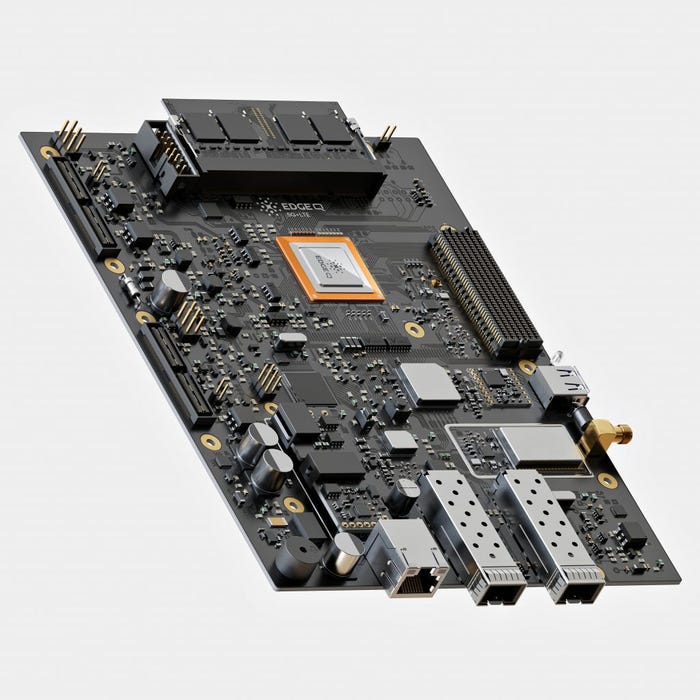EdgeQ gets $75m funding to disrupt Open RAN
As it closes a big round of funding, Telecoms.com caught up with startup EdgeQ about its Intel-rivalling ‘base station-on-a-chip’ product, which it's hoping will shake up the telecoms sector.
April 20, 2023

As it closes a big round of funding, Telecoms.com caught up with startup EdgeQ about its Intel-rivalling ‘base station-on-a-chip’ product, which it’s hoping will shake up the telecoms sector.
Founded in 2018, EdgeQ’s proposition in a nutshell is that it unifies 4G and 5G onto a single chip for telecoms infrastructure, which can be customised in performance and features via software upgrades – or to put it another way what it is selling is a ‘base station-on-a-chip.’
In an Open RAN context this makes it an Intel rival, which is something the chip giant doesn’t really have many of.
Yesterday it announced the appointment of Lattice Semiconductor CEO and President Jim Anderson to the company’s board of directors, and that it has closed a $75 million Series-B investment round of funding, which will go towards ramping up production to meet the ‘ever increasing demands for a scalable 5G solution.’
We spoke to Vinay Ravuri, Founder and CEO of EdgeQ about the nuts and bolts of the offering, what it means for Open RAN, and the potential disruption on the wider telecoms market besides.

The status quo of the telecoms industry
Describing the historical context of the telecoms infrastructure market, Ravuri says: “Because of lack of solutions for this particular industry, companies have gone vertical. These are the Nokia’s and Ericsson’s of the world. And they’re specialised that way, in the sense that they are wireless companies. They just focus on that, top to bottom. Chips come from them, boxes come from them, software comes from them, cables come from them – everything is 100% verticalized. When you do that, you tend to become very proprietary and closed. And also it’s just the nature of these things when you evolve over several decades you build on legacy, you don’t clean slate anymore.”
Up until fairly recently that was how telecoms networks got built – with full, closed solutions from big kit vendors like Ericsson, Nokia or Huawei. However with the rise of Open RAN as a solution and a talking point, the market is supposed to have opened up.
“On the other end take these other companies that are there today – semiconductor companies, Intel, Nvidia – these are again the big iron companies that that go into the data centre,” says Ravuri. “So they try to sell that those chips that weren’t really meant for telco, meant for enterprise, but they will try to resell them to the extent they can. So there’s nothing new here other than just existing chips that are high power and high performance.
“We felt that particularly given that 5G is becoming more enterprise centric – meaning not just the cell phone world but also on the edge – there’s a lot of need for a chipset company that can optimise the design point for enterprise and that’s where we come in. There’s two types, one is the indoor application like small cell, which looks almost like an access point, and then you’ve got this outdoor version that maybe sits on the bottom of a cell tower. But in both scenarios, we offer half the costs half power, and it’s an open architecture solution. It’s very different.”
The technology of the ‘base station-on-a-chip’
So that’s the market as it stands – a tripodic legacy of three main providers with a nascent, supposedly more open alternative. We asked Edge Q to expand upon what it is that is so different with what it is bringing to the table.
“We’ve implemented many of these cores inside the chip, [have] patents up the wazoo, we’ve modified the instruction set. So we are one of the more unique players out there. Picking this up a level what it comes out as is you get a nice layer one, layer two, layer three, all integrated into a single chip, which is pretty much the whole base station. It can be realised as a small cell, that’s one modality, the other is it could be realised as a macro cell in Open RAN. In Open RAN speak this is called a distributed unit (DU).
“The net of it is if you look at it at a brass tax level, we are 50% of the power compared to the best of breed competition and 50% of the cost compared to the best of breed out there. And that’s our differentiation, whether it’s Qualcomm, Intel, it doesn’t matter – comparing best of theirs to best of ours. And how we get to that is the fact that we massively integrated a bunch of functions, we’re the only one that does 4G and 5G on a single chip, we’re the only one that has a CPU integration into it. These discrete components typically are more than 10 chips, and we’ve integrated six of them into a single chip.”
The brass tax
Open RAN is pitched in general as being all about open systems that can be made up of components and software from an array of competing firms. However it has been pointed out that there is a slight fly in the ointment for that philosophy since there hasn’t up until now seemed to be much in the way of an alternative to Intel on the chip side, whoever is providing the rest of the kit. Edge Q also claims what is currently on the table in terms of Open RAN is roughly double the price of off-the shelf products from the big kit vendors.
“This is a typical Intel solution”, Ravuri said indicating to a slide during the interview. “You have a big honking CPU, another card for FAC, and then you have a NIC card, timing sync, memory, SSD and all that. Put this together for a three sector base station, like a massive MIMO base station, it’s a $5,000 price point in a server form factor. This does not include layer two or three software yet, [it’s] just this today. The equivalent from Nokia Ericsson is about half of this price.
“There is your problem. You can’t have the new thing be 2X the price of the old thing. So this is not a solution for the long term. This is in fact something to get a price discount from an existing vendor really if anything. So, we are changing this. Bringing this down to a $2,000 thing is the problem statement for 5G or Open RAN, and that is where we’re attacking this.”
When asked if the pricing disparity as described is something that has perhaps stifled Open Ran uptake to this point, Ravuri added: “Absolutely. I would say it’s the biggest obstacle.”

Upsetting the apple cart
Offering half the cost and half the power consumption, which also translates as cost, is presumably a pretty strong pitch to telcos who are currently having their margins squeezed. However Ravuri describes the telecoms industry as conservative in its thinking, and it is choosing its customers carefully.
“Certainly our customers, operators, describe us as disruptors, a once in a generation type in this space that they have seen. They do see us as changing the game, which is kind of slow moving, into something much more fast paced. They do say all of those right things. But the ultimate test is this. It’s also a very conservative industry. They like to play with things, but they don’t necessarily just go jump right into it. Because nobody wants to get fired for doing something new. So that’s the challenge, but someone has to upset the apple cart. And there will always be one or two players that will make that change and they win, they beat all the incumbents that way. Those are the people that we look to as customers.
“I don’t go after the largest companies because they will take five years only to publish a report internally and still do the same thing they’ve done in the past. I have to be realistic about those things. And eventually they will all follow because they would have gotten their pants beat by someone else. But the key is for now, no matter how innovative you are to survive and to do the right thing you have to know who’s the right customer. Not everyone is the right customer, and that’s the job I have – to make sure I steer the company in the in the right direction.”
Get the latest news straight to your inbox. Register for the Telecoms.com newsletter here.
About the Author
You May Also Like










.png?width=300&auto=webp&quality=80&disable=upscale)


_1.jpg?width=300&auto=webp&quality=80&disable=upscale)